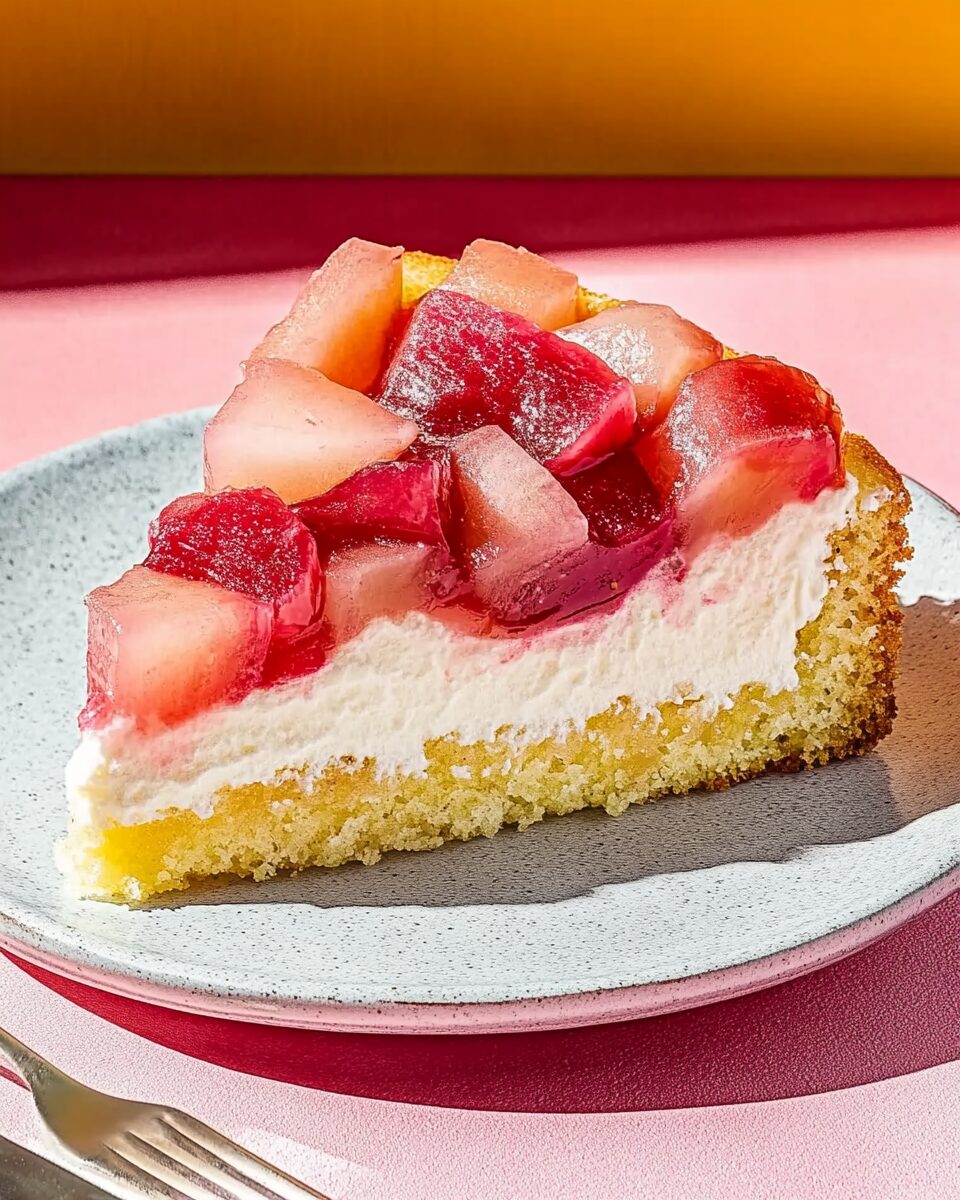Rhubarb Upside-Down Cake is a delightful dessert that combines the tartness of rhubarb with a sweet, spongy cake base. This visually appealing treat is perfect for showcasing fresh rhubarb during its peak season. The caramelized rhubarb topping adds a burst of flavor and a pop of color, making it an excellent choice for springtime gatherings.
Full Recipe:
Ingredients
For the rhubarb layer:
- 3 cups sliced fresh or frozen rhubarb
- 1 cup sugar
- 2 tablespoons all-purpose flour
- 1/4 teaspoon ground nutmeg
- 1/4 cup butter, melted
For the batter:
- 1/4 cup butter, melted
- 3/4 cup sugar
- 1 large egg, room temperature
- 1-1/2 cups all-purpose flour
- 2 teaspoons baking powder
- 1/2 teaspoon ground nutmeg
- 1/4 teaspoon salt
- 2/3 cup 2% milk
- Sweetened whipped cream, optional
Directions
- Place rhubarb in a greased 10-inch cast-iron or other heavy ovenproof skillet. Combine sugar, flour, and nutmeg; sprinkle over rhubarb. Drizzle with melted butter.
- For the batter, in a large bowl, beat the melted butter and sugar until blended. Beat in the egg. In a separate bowl, combine the flour, baking powder, nutmeg, and salt. Gradually add the dry mixture to the egg mixture alternately with milk, beating well after each addition.
- Spread the batter over the rhubarb mixture. Bake at 350°F until a toothpick inserted in the center comes out clean, about 35 minutes. Loosen the edge immediately and invert onto a serving dish. Serve warm. If desired, serve with whipped cream.
Nutrition Facts
Per serving (1 piece):
- Calories: 316
- Fat: 10g (6g saturated fat)
- Cholesterol: 48mg
- Sodium: 248mg
- Carbohydrate: 53g (36g sugars, 1g fiber)
- Protein: 4g
Historical Context of Rhubarb in Desserts
Rhubarb, often referred to as the “pie plant,” has a storied history in culinary traditions, particularly in desserts. Originating from Asia, rhubarb was initially valued for its medicinal properties. Over time, its culinary potential was recognized, and it became a staple in European kitchens, especially in the United Kingdom and Scandinavia. In these regions, rhubarb was commonly used in pies, crumbles, and tarts, balancing sweetness with its natural tartness. The introduction of rhubarb to North America further cemented its status as a beloved dessert ingredient, leading to the creation of various rhubarb-centric recipes, including the Rhubarb Upside-Down Cake.
The Art of the Upside-Down Cake
The concept of the upside-down cake dates back to the early 20th century, with pineapple being the most popular topping. This method involves arranging fruit and a sugary glaze at the bottom of the baking pan, which, after baking, becomes the top of the cake once inverted. The result is a visually stunning dessert with a caramelized fruit layer. Applying this technique to rhubarb offers a refreshing variation, allowing the unique flavor and color of rhubarb to take center stage.
Health Benefits of Rhubarb
Beyond its culinary appeal, rhubarb offers a range of health benefits, making it a valuable addition to a balanced diet.
Bone Health
Rhubarb is a rich source of vitamin K, a nutrient essential for bone health. A half-cup serving of cooked rhubarb provides more than one-third of the recommended daily intake of vitamin K, which plays a crucial role in bone formation and may help prevent osteoporosis.
Digestive Health
The fiber content in rhubarb supports digestive health by promoting regular bowel movements and preventing constipation. Additionally, compounds like sennosides act as natural laxatives, further aiding digestion.
Heart Health
Regular consumption of rhubarb has been linked to improved heart health. Its high fiber content helps lower cholesterol levels, reducing the risk of heart disease. The antioxidants present also provide anti-inflammatory effects, contributing to overall cardiovascular well-being.
Antioxidant Properties
Rhubarb contains antioxidants such as anthocyanins and proanthocyanidins, which help combat free radicals in the body. These antioxidants may reduce the risk of chronic diseases, including certain types of cancer.
Skin Health
The vitamin A in rhubarb may help combat free radicals that cause skin damage and premature aging, promoting healthy and youthful-looking skin.
Culinary Variations
While the traditional Rhubarb Upside-Down Cake is a favorite, there are numerous variations to explore:
-
Crumb-Topped Delight: Incorporate a crumb layer at the bottom of the pan to add a delightful crunch to the dessert. This variation offers a surprise texture that complements the soft cake and tender rhubarb.
-
Spiced Infusion: Enhance the flavor profile by adding spices such as cinnamon, nutmeg, or cardamom to the batter. These spices introduce warm, aromatic notes that pair wonderfully with the tartness of rhubarb.
-
Nutty Addition: Incorporate chopped nuts like almonds or walnuts into the batter or sprinkle them on top before baking. Nuts add a rich, nutty flavor and a satisfying crunch.
-
Berry Fusion: Combine rhubarb with other fruits such as strawberries or blueberries for a mixed-fruit upside-down cake. This fusion introduces additional sweetness and complexity to the dessert.
Crafting the Perfect Rhubarb Upside-Down Cake
To create a memorable Rhubarb Upside-Down Cake, several key elements should be considered:
-
Selecting Quality Rhubarb: Choose fresh, firm stalks with a vibrant pink color. Avoid wilted or discolored stalks, as they can affect the cake’s flavor and appearance.
-
Preparing the Rhubarb Layer: Cut the rhubarb into uniform pieces to ensure even cooking. Arranging the pieces artistically in the pan can enhance the cake’s visual appeal.
-
Creating the Caramel Base: A mixture of butter and brown sugar forms the caramel that envelops the rhubarb. This layer imparts a rich, molasses-like sweetness and aids in the caramelization process during baking.
-
Baking Techniques: Using a heavy-bottomed pan, such as a cast-iron skillet, helps distribute heat evenly, promoting uniform caramelization. It’s crucial to monitor the baking time to prevent overcooking, which can lead to a tough texture.
-
Inversion and Serving: Allow the cake to cool briefly before inverting to prevent the rhubarb from sticking. Serving the cake warm, optionally with a dollop of whipped cream or a scoop of vanilla ice cream, enhances the overall experience.
Variations and Creative Twists
While the classic Rhubarb Upside-Down Cake is a treat on its own, there are numerous ways to personalize and experiment with the recipe:
-
Incorporating Spices: Adding spices such as cinnamon, nutmeg, or cardamom to the batter can introduce warm, aromatic flavors that complement the tartness of the rhubarb.
-
Nutty Additions: Incorporating chopped nuts like almonds or pecans into the batter or as a topping can add a delightful crunch and depth of flavor.
-
Citrus Zest: Infusing the batter with citrus zest, such as orange or lemon, can brighten the cake’s flavor profile, balancing the richness of the caramelized rhubarb.
-
Alternative Flours: For a gluten-free version, substituting all-purpose flour with almond flour or a gluten-free flour blend can cater to dietary preferences without compromising texture or taste.
-
Serving Suggestions: Pairing the cake with a rhubarb compote or a drizzle of rhubarb syrup can intensify the fruit’s flavor, creating a harmonious dessert experience.
Nutritional Considerations
While Rhubarb Upside-Down Cake is a delectable indulgence, it’s important to be mindful of its nutritional content:
-
Calories and Macronutrients: A standard serving contains approximately 316 calories, with a balance of carbohydrates, fats, and proteins.
-
Sugar Content: The cake includes both refined sugars and natural sugars from rhubarb. Moderation is key for those monitoring sugar intake.
-
Dietary Fiber: Rhubarb contributes a modest amount of dietary fiber, aiding in digestion.
-
Allergen Information: The recipe contains common allergens such as gluten, dairy, and eggs. Substitutions can be made to accommodate allergies or intolerances.
Conclusion
Rhubarb Upside-Down Cake is more than just a dessert; it’s a celebration of seasonal ingredients and culinary tradition. Its harmonious blend of tart rhubarb and sweet, buttery cake offers a satisfying conclusion to any meal. By understanding its history, mastering its preparation, and exploring various adaptations, bakers can create a personalized version that delights the senses.






